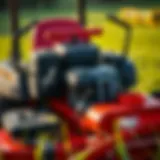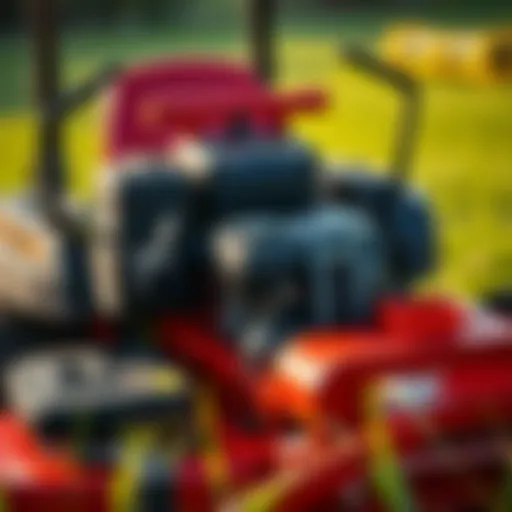Analyzing Stihl S Equipment for Agriculture
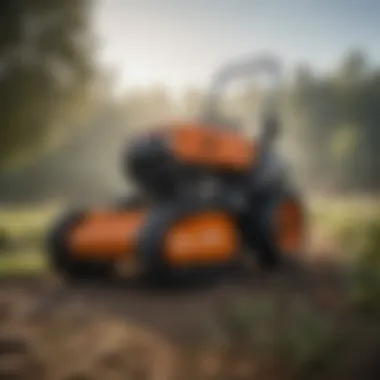

Overview of the Topic
Definition and Importance
The Stihl S range of equipment has carved a notable niche in the agricultural sector, known for its exceptional reliability and durability. Stihl, a brand synonymous with power tools, has tailored this line specifically for agricultural use—focusing on the needs of farmers and horticulturists alike. The relevance of the Stihl S range is significant for modern agronomy as it intertwines efficiency with sustainability, catering to new agricultural practices that demand precision and environmental responsibility.
It’s not just about cutting down weeds or maintaining gardens. The tools within this range represent a shift towards smarter, more sustainable farming methods. Farmers are increasingly drawn to tools that enhance productivity without compromising the integrity of the environment.
Current Trends
In today's agricultural landscape, there is a growing trend towards automation and precision farming techniques. The integration of advanced technology in operational practices is becoming a common sight in fields.
- Sustainable Practices: Farmers are heavily investing in equipment that supports eco-friendly operations—reducing emissions and conserving resources.
- User-Centric Design: Tools are now designed with the user’s comfort in mind, ensuring efficiency and ease of operation.
- Data-Driven Decision Making: New gadgets record performance metrics, allowing farmers to fine-tune their approaches.
As these trends become increasingly mainstream, equipment like the Stihl S tools becomes a crucial asset in achieving farming goals efficiently.
Key Techniques and Practices
Step-by-Step Guide
To harness the full potential of Stihl S equipment, farmers should follow a structured approach:
- Research Needs: Identify the specific tasks required within your agricultural practices—this helps in selecting the right tools.
- Training and Familiarization: Ensure that you or your staff are adequately trained in using the tools to maximize their efficiency. This is key for safety and productivity.
- Regular Maintenance Checks: Adopting a routine maintenance schedule helps ensure your equipment functions optimally and extends its lifespan.
- Adaptability: Farm demands can shift based on seasons, so being adaptable with the equipment usage is vital.
Tools and Equipment Needed
The Stihl S series offers a diverse array of tools such as:
- Chainsaws: For heavy-duty cutting tasks.
- Hedge Trimmers: Ideal for precision trimming in ornamental gardens.
- Blowers: Effective in maintaining cleanliness around farm premises.
- Cut-off Machines: Useful in construction or hard landscaping applications.
These tools are engineered to support rigorous agricultural activities, promoting efficiency in various operations.
Challenges and Solutions
Common Obstacles
While the Stihl S range presents numerous advantages, it does come with challenges:
- Initial Investment Costs: For small farms, the upfront cost of purchasing these tools can be a hurdle.
- Maintenance Requirements: Like any high-performance machinery, regular upkeep is necessary, which can require additional time and investment.
Innovative Solutions
Addressing these challenges can lead to remarkable outcomes:
- Lease or Rent Equipment: For farmers with budget constraints, exploring leasing options or renting tools can alleviate the financial burden.
- User Communities: Engaging in forums or groups on platforms like Reddit can provide insights and shared experiences on managing costs effectively.
"Proper investment and understanding of how to use the tools can lead to increased yields and reduced labor in the long run."
By understanding both the potential and the challenges that come with Stihl S equipment, farmers can make informed decisions that could enhance their operational efficacy.
In this exploration of the Stihl S range, we aim to paint a clear picture of how these tools can seamlessly integrate into modern agricultural practices, ensuring that readers walk away with a comprehensive understanding of their application and benefits.
Prolusion to Stihl S
Understanding the significance of Stihl S in today’s agricultural landscape is essential for farmers and horticulturalists alike. This range of equipment plays a pivotal role in enhancing productivity and efficiency on the field. By delving into various aspects of Stihl S tools, users can gain insights that lead to informed decisions about their agricultural practices.
The Stihl name carries a legacy filled with innovation and commitment to quality that resonates within the agricultural community. Farmers are often faced with the challenge of selecting the right tools among a myriad of options, making the recognition of Stihl's benefits even more crucial.
History and Heritage of Stihl
The roots of Stihl trace back to 1926 when Andreas Stihl Sr. founded the company in Germany, primarily focusing on the development of chain saw technology. This dedication soon blossomed into an engaging journey paving the way for other power tools. Over the decades, Stihl has fostered a tradition not only of innovation but also of reliability. The brand quickly became synonymous with durable tools that could withstand the demands of agricultural work.
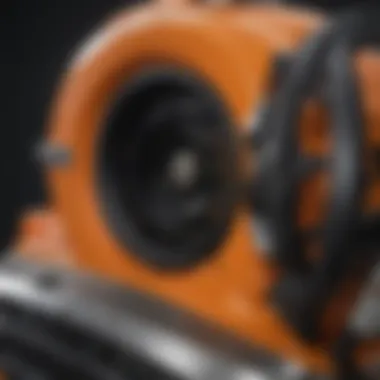

Through its various evolutions and adaptations, Stihl has maintained a steadfast reputation for excellent performance and durability. In numerous farms around the globe, it has etched its mark into the equipment arsenal, giving users the confidence they need in their day-to-day operations. Farmers today are not just using tools; they trust a legacy that stands behind them.
Overview of Stihl S Product Line
The Stihl S product line comprises a diverse array of tools, particularly designed to cater to the multifaceted needs of modern agriculture. From chain saws to trimmers, blowers, and the like, the assortment is indeed impressive. Each model is built with particular attention to detail, ensuring that every tool meets specific standards of performance and practicality.
Key highlights include:
- Chain Saws: Known for their effective cutting capabilities, perfect for managing woods and clearing land.
- String Trimmers: Ideal for maintaining fields and edges, making it easier to care for crops and landscapes.
- Blowers: These are essential for clearing away debris, especially after harvest season, ensuring a clean working area.
In summary, the Stihl S product line not only aids in carrying out operational tasks but also increases overall efficiency on the farm. Selecting the right tool from this line translates into clear improvements and optimal results, yet, understanding the key differentiators among each tool is vital to maximizing their full potential.
Technical Specifics of Stihl S Equipment
Understanding the technical specifics of Stihl S equipment is crucial for anyone involved in agriculture. The tools need to be more than just simple machines; they must integrate seamlessly into a farmer's daily routine. This is where the unique aspects of Stihl S shine. Not only do these tools offer reliability and innovation, but they also promote efficient agricultural practices that can significantly enhance productivity.
Engine Performance Characteristics
When it comes to agricultural machinery, the heart of any tool is its engine. With Stihl S equipment, you can expect powerful engine performance tailored to the demands of farming tasks. Equipped with advanced technology, these engines are designed for efficiency, durability, and reduced maintenance needs. Users often mention how a robust engine translates into a better operational experience; less time dealing with machinery means more time for farm duties.
"A reliable engine means I can focus on the crops, not on repairs."
— Experienced Farmer
Stihl S engines utilize innovative features that optimize fuel consumption. Farmers appreciate these engines for their ability to deliver consistent performance while using less fuel. This not only cuts costs but also minimizes environmental impact, making them a suitable choice for eco-conscious users. Additionally, engines in the Stihl S line are usually lighter than those found in competitors' equipment, contributing to improved maneuverability in the fields.
Design Innovations and Ergonomics
Innovation in design is another standout characteristic of Stihl S equipment. Ergonomically designed tools aim to reduce user fatigue, enhancing comfort during prolonged use. Stihl engineers have taken user feedback into account, crafting tools that fit naturally into the hand and provide natural motion, which ultimately leads to less strain on the body.
For instance, features like anti-vibration systems are incorporated into various tools to minimize the stress on the user's hands and arms. The handle's grip is often designed to accommodate different hand sizes, ensuring that people can work comfortably, regardless of how long they use the equipment. These design innovations allow farmers to work longer hours without the discomfort that can come from using less thoughtfully designed tools.
Comparative Analysis with Other Brands
No product exists in a vacuum, and assessing Stihl S tools alongside other brands can draw a clearer picture of their value. Competitors have their merits, but Stihl S often stands out due to a combination of innovative technology and practical design. For example, when compared to products from brands like Husqvarna or Echo, many users have noted that Stihl S products tend to have an edge in engine efficiency as well as ergonomics.
Some farmers find that Stihl S tools need less frequent repairs and maintenance over time. While initial costs might be slightly higher than some alternatives, many professionals view them as a solid investment due to their longevity and reliability. Plus, the resale value of Stihl S tools generally remains high in the market.
Operational Efficiency in Agriculture
When we discuss the intricacies of agricultural practices, one cannot overlook the significance of operational efficiency. It’s the backbone that empowers farmers to deliver produce in a sustainable and economically viable manner. In this section, we’ll explore how Stihl S tools fit into the larger picture of enhancing productivity while considering factors such as time management, labor costs, and resource allocation.
Operational efficiency isn’t just a buzzword; it’s a critical strategy that can tilt the balance between a thriving farm and one struggling to stay afloat. By leveraging advanced technology and equipment, like those from Stihl S, farmers can optimize their workflows, minimize environmental impacts, and improve the bottom line.
Productivity Boost with Stihl S Tools
Stihl S tools are engineered to provide a notable productivity boost in agricultural settings. One major advantage of these tools is their powerful engines combined with innovative designs that reduce user fatigue. For instance, the Stihl FS 91 R brushcutter, known for its lightweight and ergonomic frame, allows farmers to work longer hours without exhausting themselves.
- Speed and precision: With faster cutting speeds, farmers can complete tasks in less time, allowing for a more efficient workday.
- User-friendliness: Many Stihl S tools come equipped with intuitive controls, making it easier for both seasoned professionals and newcomers to operate. This lowers the learning curve and contributes directly to productivity.
- Durability: Built to last, these tools can withstand harsh conditions, reducing the frequency of replacements or repairs, which is a considerable time saver.
"What sets Stihl tools apart is not just their power but how they fit seamlessly into the user's workflow, almost like an extension of their hands."
Versatile Applications Across Farming Practices
The versatility of Stihl S tools cannot be overstated. Different types of agricultural endeavors require different types of equipment, and Stihl has crafted tools that cater to a wide array of farming practices. From small backyard gardens to expansive vineyards, the adaptive nature of these tools offers farmers a plethora of applications.
- Landscaping: Stihl S chainsaws, like the MS 271, are perfect for tree pruning and managing undergrowth which keeps farms not only functioning well but also maintaining aesthetic appeal.
- Garden maintenance: Trimmers and blowers open up possibilities for efficient weeding and general clean-up tasks without time-consuming manual labor.
- Crop management: Weed trimmers can navigate tight spaces, ensuring that every inch of farmland is productive.
The key takeaway here is that operational efficiency in agriculture, bolstered by the adaptability of Stihl S equipment, can revolutionize farming practices, fostering a new era of agricultural productivity.
Sustainability Considerations
Sustainability has emerged as a pressing concern in agriculture, influencing the way farmers and producers approach their operations. As attention turns towards methods that not only boost output but also preserve resources, the Stihl S product line stands at the forefront of this movement. When assessing agricultural tools, it is vital to consider how they impact the environment, which directly relates to the overall effectiveness and longevity of farming practices. The Stihl S range is designed not only for productivity but also for sustainable practices.
Key factors such as reduced emissions, fuel efficiency, and the materials used in manufacturing tools contribute to a more sustainable agricultural footprint. Embracing these values doesn’t just offer benefits to individual users; it fosters a collective shift toward responsible agriculture, which can ultimately lead to healthier ecosystems and communities.
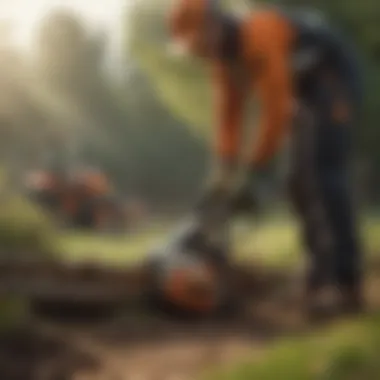

Environmental Impact of Stihl S Equipment
Understanding the environmental impact of tools in the agricultural sector is central to fostering sustainability. Stihl’s commitment to producing equipment with a lowered ecological footprint is notable. Most Stihl S models come equipped with features aimed at reducing air pollution and conserving natural resources.
For instance, Stihl’s use of advanced engine technology minimizes emissions without sacrificing performance. These engines are designed to burn fuel more completely, which results in less harmful exhaust. Additionally, many devices are engineered for durability, meaning they do not need frequent replacements, further mitigating waste.
Notably, a study indicated that equipment like the Stihl S chainsaw shows a reduction in carbon equivalent emissions compared to competitors using older technology. This kind of innovation plays a critical role in making farming operations more environmentally friendly.
"In today’s world, embracing equipment that prioritizes sustainability isn’t just wise; it’s essential for the survival of modern agriculture."
Fuel Efficiency and Emission Standards
Fuel efficiency is a critical factor to consider when evaluating tools for agricultural applications. Stihl S equipment boasts fuel-efficient engines that not only enhance productivity but also support sustainability efforts. The design is such that users don’t have to constantly fill the tank, allowing for longer periods of operation without interruption.
Moreover, these machines meet or even exceed emission standards, which vary by region but are increasingly strict globally. This is vital for farmers looking to align their operations with environmental regulations. The emphasis on meeting these standards is evident in Stihl’s engineering approach, where they invest heavily in research to ensure their products perform well while adhering to stringent environmental guidelines.
Farmers operating Stihl S tools can feel confident that they are contributing to cleaner air while maximizing their operational efficiency. In a world where the landscape of agriculture is ever-evolving, making fuel-efficient choices has become a badge of honor among conscientious producers.
User Experience and Testimonials
Understanding user experience and testimonials is crucial for grasping how Stihl S equipment operates in the real world. This section connects theoretical specifications and operational capabilities with the lived experiences of users. Insights from agricultural professionals and horticulturists shed light on the practical implications of using Stihl S tools.
User feedback not only informs potential buyers about what to expect but also provides manufacturers with essential data that can guide future product developments. Satisfied customers often share their stories on various platforms, creating a community-driven dialogue around product performance and customer service.
Case Studies from Agricultural Professionals
Agricultural professionals have been leveraging Stihl S equipment in diverse settings. One case that stands out involves a mid-sized farm in Ohio, where the owner switched to Stihl S chainsaws for their tree removal projects. The farmer reported significant time savings compared to their previous brand. They noted the balance and weight distribution of the Stihl chainsaws helped reduce fatigue during long hours of work, improving overall productivity.
Another compelling case study comes from a vineyard in California. Here, Stihl S blowers have been pivotal in maintaining cleanliness in rows of grapevines, which is crucial for avoiding mildew outbreaks. The vineyard manager emphasized that their decision to use these blowers reduced labor costs while increasing air circulation. They highlighted how the leaf blowers’ quiet operation allowed work to take place without disturbing wildlife—a point they felt was very important for sustainable farming practices.
These case studies not only showcase the broad utility of Stihl S tools but also reflect the emphasis on efficiency and sustainability in modern agriculture.
Feedback from Horticulturists
Horticulturists often have different needs and expectations when it comes to equipment. A common theme in feedback from these professionals centers on the precision and ease of use that Stihl S tools provide.
One horticulturist mentioned how the Stihl S hedge trimmer allowed for clean cuts on delicate plants, promoting healthy growth without inducing stress on the foliage. This precision resulted in fewer plant losses and better aesthetics, which are essential in landscaping.
Moreover, the battery-operated options within the Stihl S lineup have received commendation for their lightweight nature and minimal noise. A local landscaper working in residential areas remarked how using noise-reduced equipment made compliance with local noise ordinances easier, thereby enhancing customer satisfaction.
In sum, the juxtaposition of feedback from farmers and horticulturists displays the versatility of Stihl S tools. Each user’s perspective contributes to a deeper understanding of how these instruments fit into the larger puzzle of agricultural and horticultural practices.
"Real-world experiences provide a better grasp of Stihl S effectiveness than any brochure ever could."
By embracing the diverse voices within this community, potential buyers are empowered to make informed decisions that align with their specific goals.
Maintenance and Longevity
When it comes to agricultural equipment, the longevity and maintenance of tools and machinery are paramount. Keeping your equipment in top shape ensures not just performance but also safety and cost-effectiveness. With Stihl S tools, the focus on easy maintenance is matched by their durability, making them a sound investment for farmers who depend on their tools daily. Understanding the routine care needed to maintain these tools can greatly enhance their operational lifespan and effectiveness in the field.
Routine Care Practices for Stihl S Tools
Regular maintenance is the lifeblood of any agricultural tool. For Stihl S equipment, establishing a routine can prevent breakdowns and prolong functionality. Here are some key practices:
- Clean After Use: Always wipe down your tool after a job. Dirt and debris can cause mechanical issues over time.
- Inspect for Wear: Regularly check for any obvious signs of wear, such as frayed cords or dull blades. Identifying these issues early can prevent larger problems later.
- Lubrication: Apply lubricant to moving parts as per the manufacturer's recommendations. This simple step helps manage friction and corrosion.
- Check Filters: Clean air filters regularly to ensure optimal engine performance. Clogged filters can result in inefficient fuel consumption.
- Battery Health: For any battery-powered tools, check the battery’s health and charge level frequently. Keeping it in good shape guarantees better performance and efficiency.
Implementing these practices can ensure that your Stihl S tools remain efficient and reliable, ultimately saving farmers time and money.
Troubleshooting Common Issues
Even the finest tools can face troubles from time to time. Knowing how to troubleshoot common problems can save you from unnecessary downtime. Here are some common issues and their possible solutions:
- Engine Won't Start:
- Poor Cutting Performance:
- Excessive Vibration:
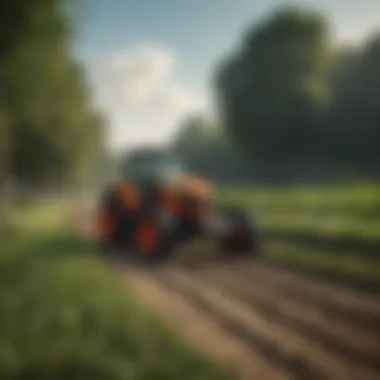

- Check Fuel Supply: Ensure there is sufficient fuel in the tank. Sometimes, it might be as simple as running out of gas.
- Inspect the Spark Plug: A dirty or damaged spark plug can prevent ignition. Clean or replace it if necessary.
- Dull Blades: If the tool is not cutting effectively, sharpen the blades. This is crucial for maintaining efficiency.
- Clogged Filters: Again, air or fuel filters may become clogged, limiting performance. Cleaning them should be a priority.
- Loose Components: Check for any loose screws or bolts. Tightening these can help reduce vibration and enhance user comfort.
"Routine maintenance can save not only your equipment but also your farming operation from needless hiccups."
By familiarizing yourself with these possible issues and solutions, farmers can better manage their Stihl S tools, ensuring they remain productive and reliable. Remember, maintaining equipment isn’t just about fixing problems; it’s also about preventing them before they start.
Economic Factors
Understanding the economic factors associated with the Stihl S range of equipment is crucial for farmers contemplating an investment. In today's fast-paced agricultural landscape, where margins can be thin, farmers must balance upfront costs with long-term benefits. These economic elements are more than mere numbers on a spreadsheet; they encapsulate the strategic choices that can affect productivity, efficiency, and ultimately, profitability.
Cost-Benefit Analysis of Stihl S Investment
When weighing the cost of Stihl S equipment, one needs to look beyond the initial purchase price. This assessment involves considering various factors, such as:
- Longevity and Reliability: The Stihl S line is known for its durable construction and low maintenance needs. Investing in robust tools often means reduced expenses over time. For example, an average Stihl chainsaw can last for years if maintained properly, which may save farmers significant replacement costs.
- Increased Productivity: Efficient tools can lead to enhanced productivity. A reliable Stihl brushcutter might cut down time spent clearing fields substantially. This time-saving translates to more hours available for essential tasks, improving overall farm output.
- Enhanced Crop Yield: Proper tools contribute to better farming practices, impacting crop yield positively. A farmer investing in a Stihl tiller may notice improved soil conditions and healthier plant growth, thus increasing harvest volume and quality.
"A tool that lasts is worth its weight in gold. Investing in Stihl S is investing in the future of your farm."
The above factors should be weighed against direct costs such as purchase price and operational expenses. This kind of detailed analysis can enhance one’s financial judgment and highlight why Stihl S can be a good long-term investment.
Financing Options for Agricultural Purchases
Budget constraints are a reality for many in the agricultural sector. Fortunately, various financing options cater specifically to farmers looking to secure quality equipment like the Stihl S tools.
- Leasing vs. Buying: Leasing equipment allows farmers to use the latest technology without the hefty upfront costs. It’s especially beneficial for tools that may only be used seasonally. On the other hand, outright purchases might seem daunting initially but can lead to overall savings in the long run, especially if tools are utilized year-round.
- Bank Loans: Many banks and credit unions offer loans targeted at agricultural equipment purchases. Lower interest rates and longer repayment terms are often available to help lighten the financial load.
- Manufacturer Financing Programs: Many manufacturers, including Stihl, offer their own financing options. These are designed to streamline the acquisition process, which could include promotional terms or deferred payment plans.
In summary, understanding these financing avenues ensures that farmers can make informed choices, aligning their economic strategies with their agricultural goals. This balance can be the key to navigating the complexities of modern farming effectively.
Future Trends in Agricultural Equipment
The world of agricultural equipment is constantly evolving, driven by the need for increased efficiency, sustainability, and adaptability in farming practices. Understanding future trends in this field is essential for farmers and agricultural professionals, especially as they consider integrating new technologies like the Stihl S products into their operations. These trends not only influence purchasing decisions but also impact long-term sustainability and productivity in agriculture.
Innovations on the Horizon for Stihl S
As we look to the future, Stihl S is expected to push the boundaries of agricultural equipment further than before. Some innovations on the horizon include:
- Smart Technology Integration: This encompasses the use of IoT devices and sensors to monitor equipment performance and provide real-time data. Farmers might access analytics directly on their mobile devices, enabling informed decision-making.
- Battery-Powered Equipment: With a shift towards electric and battery-operated tools, Stihl S products are likely to embrace this trend. This would reduce carbon footprints and minimize noise pollution, making operations more pleasant for those working in sensitive environments.
- Enhanced Ergonomics: Innovations in design will likely focus more on user comfort, reducing fatigue during long hours of work. This may include adjustable handles, weight distribution features, and materials that lessen vibrations.
"The future of agricultural tools is not just about performance. It's about making the farmer's life easier and greener."
Impact of Technology on Farming Tools
Technology's influence on farming tools is profound and multi-faceted. The adoption of advanced tools goes beyond mere convenience; it leads to increased productivity and resource efficiency. Here are some specific impacts to consider:
- Precision Agriculture: Through the use of GPS and sensors, farmers can achieve highly localized farming practices. This technology allows for tailored irrigation, fertilization, and Pest Management, optimizing resources and yield.
- Automation: The rise of robotics and automation is also evident. Smaller farms are starting to benefit from automated solutions that were once the reserve of large-scale operations. Stihl S may leverage automated features to appeal to this market.
- Data-Driven Decisions: With improvements in software capabilities, farmers can analyze crop performance and equipment usage effectively. The integration with Stihl S tools could enhance operational management by providing insights into equipment optimization.
Culmination
Wrapping up this analysis of Stihl S equipment paints a vivid picture of how vital these tools are in the agricultural sphere. The advantages offered by this particular range can’t be overstated; we're not just talking about tools that get the job done, but rather instruments that can significantly enhance productivity and streamline operations on the field.
Summation of Insights
One of the major highlights of the Stihl S range is its relentless focus on user-centric design. The balance between power and maneuverability is a game-changer for farmers. Here’s a breakdown of the main points discussed:
- The history of Stihl showcases a legacy of innovation, which resonates through their current product line.
- Technical features like engine performance, ergonomic designs, and attention to user feedback play a crucial role in everyday tasks.
- Operational efficiency is amplified with tools that fit various agricultural practices seamlessly, making them a versatile ally on the farm.
- Sustainability has become a non-negotiable aspect, with Stihl S equipment resonating with eco-conscious practices through improved fuel efficiency and reduced emissions.
This summation not only condenses the essential elements of the discussion but also sets the stage for considering Stihl as a cornerstone in modern agricultural methodologies.
Final Thoughts on Stihl S in Agriculture
In these rapidly changing times, where demands on farmers increase, the tools they choose become paramount. Stihl S has forged a niche that intertwines high performance with reliability and sustainability. As we stand at the crossroads of technology and tradition in agriculture, Stihl S presents itself as a partner rather than just a provider of tools. Every aspect of the user experience, from initial purchasing considerations to the long-term maintenance of equipment, has been thoughtfully addressed.
Whether you're a seasoned farmer or a budding agricultural enthusiast, these tools can undoubtedly meet expectations and even deliver beyond them. Investing in Stihl S means not just enhancing productivity but also committing to sustainable practices that protect the earth and ensure that farming remains viable for generations to come.
"To cultivate means much more than just to plant and reap; it’s about nurturing the future—Stihl S tools help us do just that."
